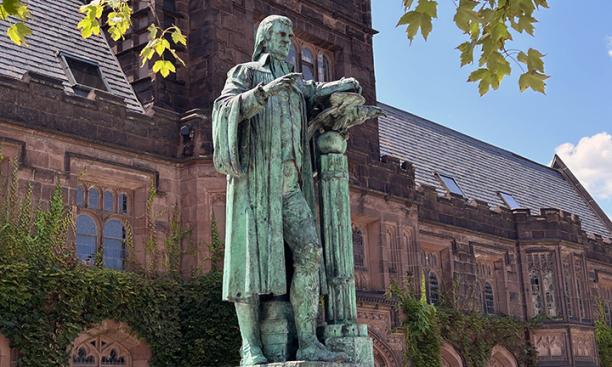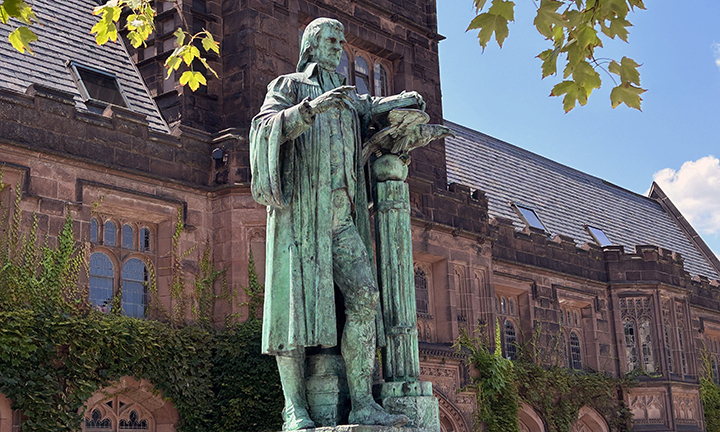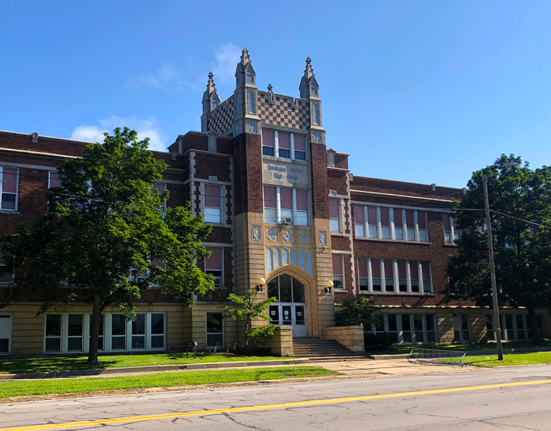
Princeton’s statue of John Witherspoon.
Brett Tomlinson
One speaker at the symposium called it ‘a bad work of art’
Though the speakers at the second Committee on Naming symposium on Princeton’s John Witherspoon statue were specifically asked not to make recommendations for the future of the statue, one presenter advocated for the destruction or permanent storage of monuments with ties to racism, and others alluded to adding contextual information, displaying it in the University’s new art museum, displaying an empty pedestal, and toppling the statue, which one presenter described as “a bad work of art.”
The future of the statue, which is located in Firestone Plaza, has been in question since 2022, when five members of Princeton’s philosophy department started a petition — eventually signed by 285 University community members — to replace it because Witherspoon, Princeton’s president from 1768 until 1794, owned slaves.
About 40 people attended the Nov. 3 event, which was moderated by Committee on Naming chair and history professor Beth Lew-Williams and featured speakers from inside and outside the University. Lew-Williams kicked things off by saying the discussion would build on the spring symposium — which considered the life and work of Witherspoon — but focus instead on the monument itself rather than the man.
The two recurring themes of the afternoon were the broader reckoning of art with connections to racism in the country and the impermanence of art, despite a widely held public perception that art is permanent.
Rachel DeLue, a professor of American art and chair of the art and archaeology department at Princeton, has discussed the Witherspoon statue and its place on campus in her classes for nearly two decades; the statue was erected in 2001. She spoke about how the statue connects Princeton with the University of the West of Scotland, which features an identical version of the statue by Scottish sculptor Alexander Stoddart, on its campus.
However, DeLue also commented that the statue “really is an odd statue” relative to the rest of the public art at Princeton, and that in her opinion, “Maybe it’s a work of art, but it’s a really bad one. It’s poorly executed. The technique is shoddy. It doesn’t look as if the sculptor had ever had a life drawing class in his training. … It’s just a bad work of art.”
Patricia Eunji Kim, an assistant professor of ancient art and culture at New York University, discussed the wider reckoning of representation within the art world, which she said speaks “to a conscious investment in the importance of taking accountability as a community and as a society.”
Kim cited other educational institutions that have dealt with controversial art — such as Duke University, which left the niche that once held a Robert E. Lee statue empty — as possible paths forward for Princeton, and reminded the audience that society should “leave ourselves open to letting go of things, especially if we are to really grapple with and participate in this current political moment … .”
Kim commended Princeton for looking into the statue issue seriously. No matter which route the University chooses, she urged that “there must be some kind of engagement with the core questions” that led to the petition for the removal. She said universities should be thought leaders in this space as they have a moral and pedological responsibility to think through the messages art can present to viewers.
Renée Ater, a visiting associate professor in Africana studies at Brown University, advocated for the destruction or permanent storage of art with ties to racism, as sometimes adding contextual information “do[es] not work in the ways that we think that they might” since labels are “stagnant” and can “shut down the conversations.”
She encouraged deeper conversations with descendants of slaves about what the “new monumental landscape” should look like in the United States.
Louis Nelson, vice provost for academic outreach and professor of architectural history at the University of Virginia (UVA), spoke about a surreptitious design competition UVA architecture students created about a decade ago — without the approval of administrators — inviting proposals for a physical remaking of the campus landscape. That eventually led to a president-approved and funded commission on slavery and UVA, which contributed to the construction of the Memorial to Slave Laborers on campus. Nelson said the memorial, which was unveiled in 2020 and is about 80 feet in diameter, “has had a fundamental impact on the way the University of Virginia understands itself and functions as a community.”
Finally, Ron McCoy Jr. *80, the University architect, spoke to the history of architecture, landscape, and art on campus. According to McCoy, “the quietness of the campus makes the Witherspoon statue stand out in such a strange way” as most of the monumental sculptures on campus are not free-standing, like the Witherspoon statue, and not as large; the Witherspoon statue is 10 feet tall and stands on an 8-foot plinth. McCoy believes the statue was installed as a result of a gift rather than growing organically out of institutional values.
In an interview with PAW, Lew-Williams commended the speakers and their varying perspectives.
“I think all of our speakers agreed that statues are not neutral, that monuments make meaning,” Lew-Williams said. “And what they were doing, I think, was to try to help us think through what kinds of meanings does this particular statue hold, … how does the statue influence the ways we understand the past, how we understand concerns of our present, and then how we imagine the future at Princeton.”
The Committee on Naming, a standing committee of the Council of the Princeton University Community (CPUC), provides advice on naming and iconography to the Board of Trustees, which will make the ultimate decision on the Witherspoon statue. Lew-Williams declined to give a timeline for the decision.







